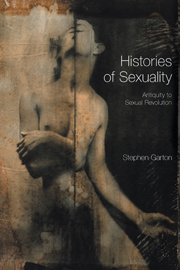Book contents
- Frontmatter
- Dedication
- Contents
- Preface
- 1 Writing Sexual History
- 2 Rule of the Phallus
- 3 Sexual Austerity
- 4 Christian Friendships
- 5 Making Heterosexuality
- 6 Victorianism
- 7 Dominance and Desire
- 8 Feminism and Friendship
- 9 Imagining Perversion
- 10 Normalizing Sexuality
- 11 Sexual Revolution
- Epilogue
- Endnotes
- Select Bibliography
- Index
8 - Feminism and Friendship
- Frontmatter
- Dedication
- Contents
- Preface
- 1 Writing Sexual History
- 2 Rule of the Phallus
- 3 Sexual Austerity
- 4 Christian Friendships
- 5 Making Heterosexuality
- 6 Victorianism
- 7 Dominance and Desire
- 8 Feminism and Friendship
- 9 Imagining Perversion
- 10 Normalizing Sexuality
- 11 Sexual Revolution
- Epilogue
- Endnotes
- Select Bibliography
- Index
Summary
In 1870 Josephine Butler, prominent English campaigner against the 1866 Contagious Diseases Acts, published ‘An Appeal to the People of England on the Recognition and Superintendence of Prostitution by Governments’, condemning the Acts as ‘deeply degrading’ because they assumed that men were ‘utterly and hopelessly slaves of their own passions’. The Acts governed naval ports and cities with military garrisons, allowing for the compulsory medical examination and incarceration of prostitutes. For Butler and her fellow campaigners, these Acts sanctioned prostitution as a necessary evil to meet the imperative sexual demands of soldiers and sailors. Instead, Butler proposed that ‘adulterous husbands and fathers’ abstain from fornication.
Similarly, in America, there were many late-nineteenth and early-twentieth century moral reform and anti-vice movements opposed to the legalization of prostitution or the introduction of contagious diseases regulations. The leaders of these organizations were politicians and moral reformers such as Anthony Comstock and Charles Parkhurst, but women, such as Charlotte Perkins Gilman, Jane Ellice Hopkins, Anna Powell, Frances Willard and Lavinia Dock, were also at the forefront of societies for moral purity and the eradication of prostitution. The ‘new abolitionists’, as historian David Pivar has described them, believed that men had to accept woman's standard of morality.
The assertion that men had to conform to a stricter morality went against the grain of ‘commonsense’ understandings of male sexuality. As Helen Lefkowitz Horowitz has argued, there was a rich nineteenth-century sexual popular culture that saw obscenity, ribaldry, prostitution and illicit sexual intercourse as natural.
- Type
- Chapter
- Information
- Histories of SexualityAntiquity to Sexual Revolution, pp. 148 - 168Publisher: Acumen PublishingPrint publication year: 2004



